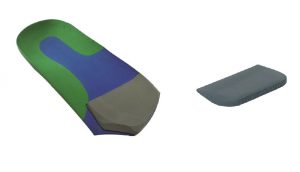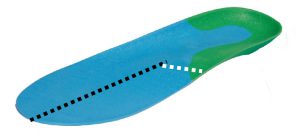
Often the orthotic device requires some adjustment to suit the patient and assist in alleviating the pain that they may be suffering.
One such deflection is a plantarflexed 1st or 1st Ray (metatarsal) cut away deflection.
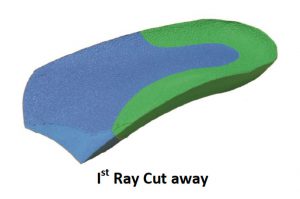
A plantarflexed 1st metatarsal phalangeal joint (MTPJ) sits plantarflexed to the lesser metatarsals and can be a fixed osseous or mobile condition which can result in the patient suffering from Sesamoiditis (inflammation or bifurcation of the sesamoid apparatus). A supinated foot position and forefoot Valgus can often accompany this condition.
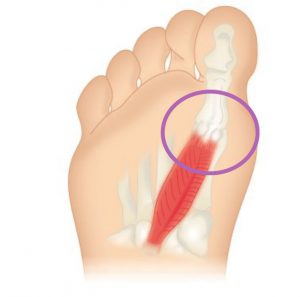
Sesamoiditis – impingement of the Sesamoid apparatusTo assess for a plantarflexed 1st place the foot in the neutral and take hold of the lesser metatarsals (2nd to 5th). Using the thumb and pointer finger to grip the 1st MTPJ and lesser metatarsals – the amount of dorsiflexion and plantarflexion should be 5mm up and 5mm down from the axis of the lesser metatarsals.
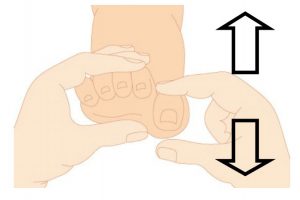
Plantarflexed 1st assessment
The image (above) indicates a mobile plantarflexed 1st, having limited dorsiflexion with significant plantarflexion.
If the joint will not move then it is a fixed Plantarflexed 1st, meaning that there is no dorsiflexion or it is minimal, and that it sits in a fixed plantarflexed position.
Treatment for a Fixed Plantarflexed 1st will be a ‘1st ray cut away’ deflection created in the orthotic which will provide 1st metatarsal relief and support to the lesser metatarsals.
Plantarflexted 1st deflection
Creating a 2/3 or ¾ length cut away
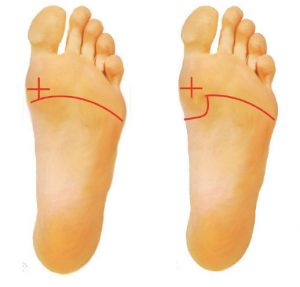
Step 1
Place the device on the base of the foot and draw an arc around the 1st metatarsal Phalengeal joint sits.
Step 2
Ensure that the 1st MTPJ is free to plantarflex and grind or linish the orthotic so that the contour is comfortable for the patient by using a hand grinder or bench grinder.
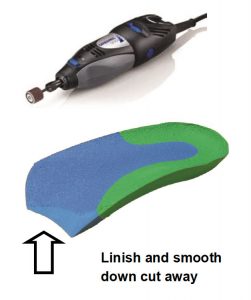
Some time the amount of support provided by the orthotic under the lesser metatarsals is insufficient and the patient will continue to feel pain under the 1st MTPJ. In this case more support may need to be affixed to the transverse arch of the orthotic to support the lesser metatarsals.
To increase support in the transverse arch, measure the difference between the axis of the lesser metatarsals and the 1st MTPJ, then add a forefoot addition wedge to the orthotic to support the lesser metatarsals. The forefoot addition should be positioned with the thickest side to-wards the distal edge of the orthotic.
To assess the amount of additional support required when the 1st MTPJ is mobile, if for example the measurement is 8mm in plantarflexion and 2mm dorsiflexion to the lesser metatarsals, subtract the 2mm from the 8mm, thus providing the required amount of support – in this case 6mm or 6°.

This type of orthotic adjustment is called a ‘2-5 Metatarsal Bar’, which can effectively decrease pressure on the metatarsal heads by supporting the metatarsal shafts.
When modifying a Full Length orthotic product to create a 1st ray trench follow the steps below:
Step 1
Mark out the width of the trench by placing the foot of the orthotic and scribing a line between the Hallux and the 2nd Phalange.
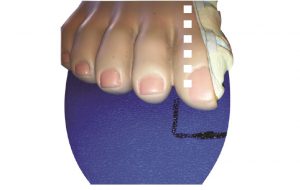
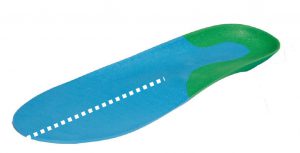
Step 2
Mark the line on an angle to allow the posterior position of the 1st MTPJ to be unimpeded by the orthotic arch.
Step 3
Place the device on a firm surface when grinding with a Dremel Hand grinder and remove the eva material leaving 1mm on the plantar surface and remove excess material behind the 1st MTP Joint.
SAVE 10% OFF ICB PRODUCTS WITH DISCOUNT CODE: 02ICB10 Offer online only!


